Atari 50: The Games They Couldn’t Include – Part Three
April 16, 2024 1 Comment
From here out, Atari 50: The Games The Couldn’t Include will be twelve games per post. I originally intended to do more and created the placeholders for several games that either looked interesting or had interesting stories behind them. When I was finished, I had over 250 placeholders. So I did the only logical thing and.. added more. I like doing these. Play them an hour, some a little less, some a lot more, write-up my thoughts. Time flies by. It’s not that different from my LCD features.
And, as always, Atari 50: The Games They Couldn’t Include wouldn’t be possible without the incredible Atari resources out there. Huge thanks to AtariMania for their instruction book library and AtariProtos.com for their directory of unreleased Atari games.
GAME REVIEWS
For those not familiar with my way of thinking of how retro games should be reviewed, I take NO historical context into account. I don’t care how important a game was to the industry, because that doesn’t make a game worth playing today. The test of time is the cruelest test of all, but every video game must face it. I might not be here if not for Pong’s success, but I wouldn’t want to play it today. Not when there’s better options. Therefore, when I review retro games, every game gets either a YES! or a NO!
YES! means the game is still fun and has actual gameplay value when played today and is worth seeking out.
NO! means the game didn’t age gracefully and is not worth seeking out, and certainly not worth spending money on.
 The Activision Decathlon
The Activision Decathlon
Platform: Atari 2600
Year: 1983
Designed by David Crane
Published by Activision
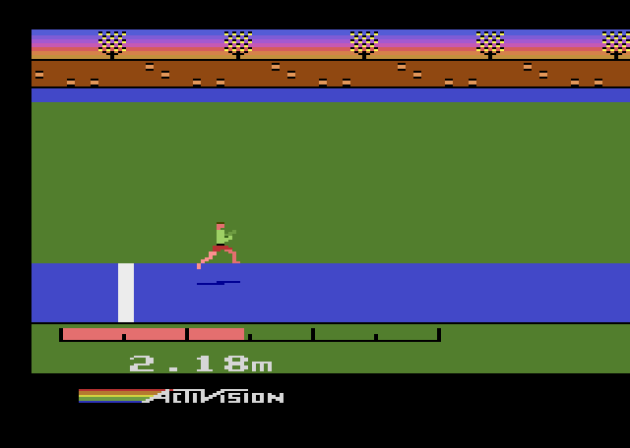
My non-athletic side apparently carries over to digital form.
For all the credit Konami gets for Track & Field, I don’t think those games hold-up especially well. So, it stands to reason the same style of game done with fewer buttons and a lot less horsepower shouldn’t hold-up at all. You can imagine my surprise that Activision Decathlon is the best of its breed I’ve ever played. This squeezes a LOT of potential out of the simple Atari 2600 joystick with ten events that use every style of button mashing or joystick wiggling you can get out of it. Most of the games require you to move the joystick. Not “rotate” or “move left and then right.” Just.. move it, by whatever technique you find most comfortable. I like that. It allows for you to come up with your own strategy. It helps if you use a control stick and not a d-pad, and it REALLY helps if you don’t play this game immediately following an extended session of a Katamari game with blisters all over your hands. But seriously, use a stick for this one.
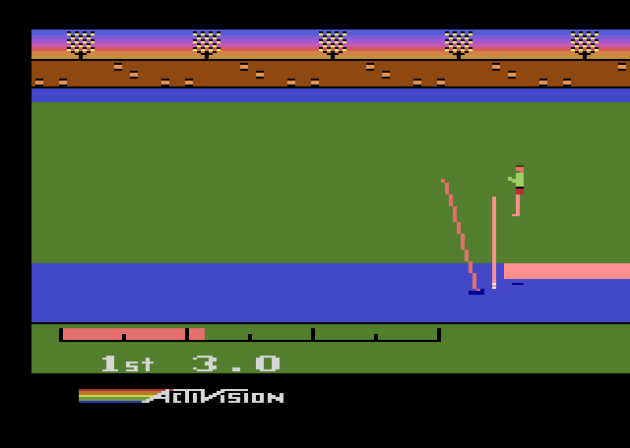
I let out a cheer the first time I completed a high jump.
There’s really only one event that’s outright boring: the 1500M. In it, the running meter is changed to require a more steady pace for the first 1,300 meters before it returns to the “wiggle the stick as fast as you can” sprint meter for the final 200M stretch. This event takes a few minutes and it’s just lifeless and boring. I’d also recommend against playing the 400M if you value the top layer of skin on your fingers. All the other events hold up pretty well, actually. The shot put/javelin/discus and even high jump/long jump events all feel kind of samey: wiggle the stick, then press the button right before the line. The only real difference in those five events is how much room you’re given to build up speed/power before you have to press the button. The pole vault changes it up somewhat, as you have to press the action button once, but you have to keep the stick movement going until you reach the top of the jump, at which point you press the action button again. I preferred the hurdles event to them, where you at least have an action button to break-up the furious stick twerking.
Before I render a verdict, I might as well do the 5200 version.
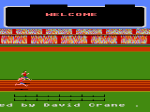 The Activision Decathlon
The Activision Decathlon
Platform: Atari 5200
Year: 1983
Designed by David Crane
Released in 1983
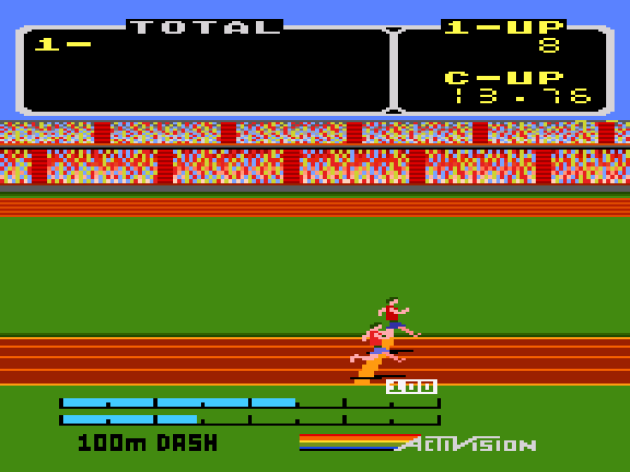
I’m exhausted from winning this one race by 0.02 seconds. Good lord, these games really do feel like they require athletic ability.
You’d think the Atari 5200 version would utilize the keypad, but thankfully that’s not the case. This is still a one button and stick-whirling experience. The big difference in the Atari 5200 version, besides a respectable graphic upgrade, is the addition of AI competitors. I couldn’t really gauge their difficulty because it seemed like the AI adjusted in real time based on my performance. You see this in the 100M especially, where no matter how I did, the AI opponent and I tended to trade the lead back and forth until the photo finish. You’re still probably better off playing against real players if that’s an option. These days, I have tremors in my hand and slower reaction time. I’m not really the best person to review games like Track & Field or Activision Decathlon. It took me multiple attempts to win the 100M dash, and I only did so by two one-hundredths of a second. I found the 5200 version to require a lot less effort in the stick moving, which was very welcome. I was still exhausted by the time I finished my playtime with these titles. The 5200 version also does a much better job of making the ten events feel distinct from one-another.
No matter which version you play, Activision Decathlon is one of the most remarkable surprises I’ve encountered in my thirteen years of reviewing video games, because it’s still fun 40 years after release. I love that events don’t have you pressing specific directions. It feels genuinely athletic, where you get better as you improve your form, a form you create and learn all on your own. For all the credit David Crane gets for Pitfall, I honestly think he deserves more for Decathlon. In terms of surviving the test of time, the degree of difficulty is so much higher in any sports game. Pitfall struggles to keep its modern relevance, but Decathlon can make a compelling argument for being the best Olympic game ever, and not just “for its time.” It works as both a casual track & field game, but also provides enough raw gameplay to satisfy hardcore players or button mashing aficionados. Sure, not every event is a winner, but the overall package still offers as much fun today as it did in 1983, and that’s a very rare quality for games of this era. Crane’s legacy is built largely on Pitfall, but it’s Activision Decathlon that proved to me he really is one of the all-time greats. These are phenomenal, and the best their genre has ever had, even four decades later. Wow.
Verdict: YES! and YES!
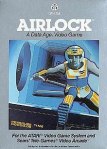 Airlock
Airlock
Platform: Atari 2600
Year: 1982
Published by Data Age
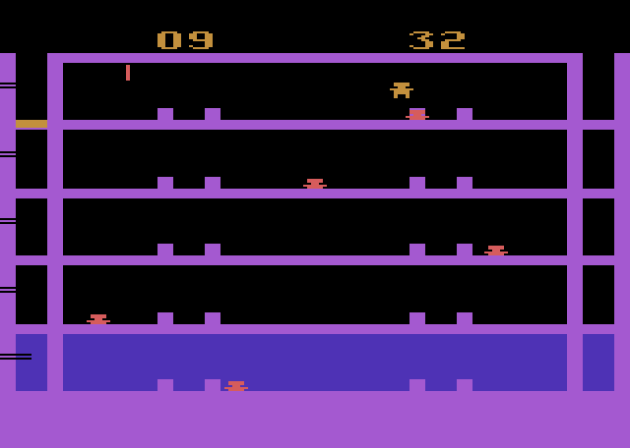
Those pink things are called “torpedoes” in the instruction book. Yes, because torpedoes are famously the ballistic weapon that, when fired, prowl rooms by walking back and forth until someone fails to jump over them.
You’ll remember Data Age as the company who tried to cash in on the Atari fad and then went all-in on the Journey license. And also as the team that put together the sublime Frankenstein’s Monster that really should have been their flagship title since it slaps. Airlock doesn’t slap. It wasn’t originally set to get a review, but then I read the premise. “A boat is sinking and you have ten seconds to exit a room before it fills with water.” That sounds exciting, doesn’t it? Sadly, the actual game is like a stripped down version of Mattel’s 2600 stinker Adventures of Tron (also in Part 2). It’s actually weird how closely it resembles that game. You zig-zag from left to right, jumping over one moving object per floor and two bumps. You have to jump up and get a key on both sides, then walk to the elevator. If you play on modes 3 or 4, you have to clear an additional room where the lumps come in pairs.
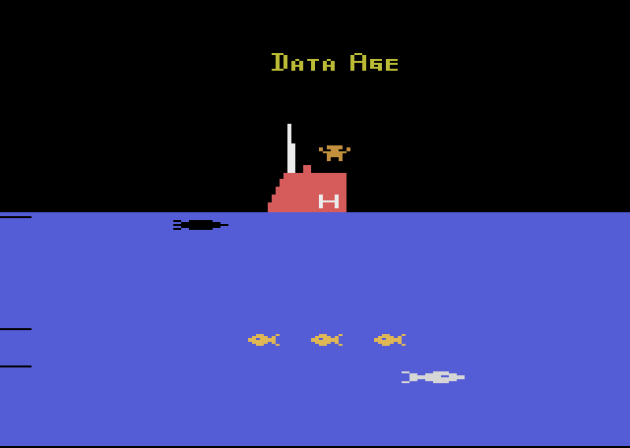
The ending screen looks more fun than playing the game itself.
And that’s the whole game. It almost sounds like there’s not enough material for anything to go wrong, but that’s not the case at all. The stationary things you have to jump over have inconsistent collision detection. If you short the jump, you’re pushed backwards away from the key you need to get, at least in theory. Sometimes, I was pushed forward, with seemingly no logic behind what causes a push back and what causes a push forward. In the modes where the bumps are doubled, there is a small learning curve towards angling the jump so you don’t just end up getting stuck between them. And of course, you have to jump over the “torpedoes” that offer almost no challenge besides making you sometimes stand still to time jumping over them. The other major problem is the game ends after 5 floors (modes 1 & 2) or 10 (3 & 4). There’s no endless mode. Not that you’d want such a thing for a game this boring, but still, when you reach the top, the game is over. There’s only two modes: 5 floors and 10, each with a two player option. That makes Airlock arguably the shortest platform game ever. I refuse to believe they couldn’t have come up with more modes. Even something as small as giving the torpedoes different patterns (say, jumping up and down themselves) would have given this desperately needed replay value. Airlock feels like the proof of concept for a platforming engine that could be used to create more ambitious games. I’m open to that being the case, given Data Age’s internal issues. By itself, it’s one of the worst on the Atari 2600.
Verdict: NO!
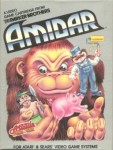 Amidar
Amidar
Platform: Atari 2600
Year: 1982
Designed by Ed Temple
Published by Parker Bros.
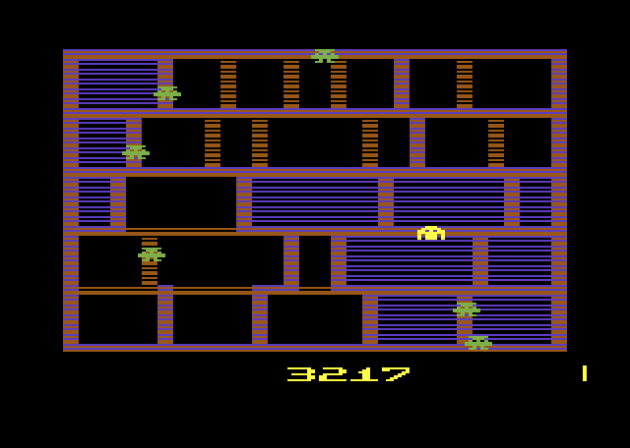
I’m the little Space Invader looking thing. That’s supposed to be a gorilla. Jeez.
I wasn’t familiar with Amidar until I began going through Atari games. It’s essentially Konami’s “what about us?” answer to Pac-Man. To Konami’s credit, it’s not bad at all, and actually is one of the stronger wannabes to follow in Namco’s wake. I’d like it a lot more except it only has two levels and is absurdly hard. The Atari 2600 port from Parker Bros. does the best it can with the limited technology to recreate the point of the coin-op. It somehow both succeeds AND it completely misses the mark and only feels like the arcade game in the sense that you have to avoid the enemies and traverse the map to collect territory. It also lacks the personality of the coin-op, leaving you with a bare bones, no frills experience. You just walk along a grid, and when you completely walk around the edge of a square, you collect it. You have to collect the whole screen while avoiding enemies. Like the arcade game, you can make the enemies jump and run under them. When you convert all four corner boxes, it’s like getting the power pellet in Pac-Man and you can eat the enemies.
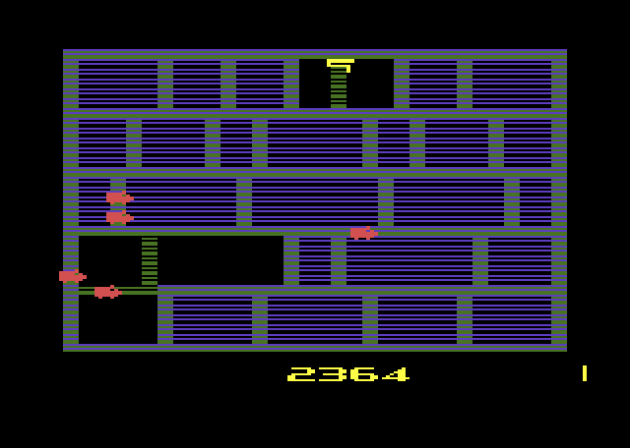
Apparently the idea behind the arcade’s second level was too advanced for the 2600.
While Amidar probably ranks among the better Atari 2600 maze chases, I have to imagine that any fan of the coin-op would have been very disappointed with this port. Not only is the charm lost, but the bonus stage is missing AND the gameplay mechanic of the second (of only two) stages isn’t present. The first level of the arcade game involves collecting dots, but that’s gone in the 2600 version and replaced by just coloring-in the pathways. That’s fine, right? It’s functionally the same thing. Well, yea, until you get to the second level. In the arcade’s second stage, you switch from a gorilla to a paint roller, and instead of collecting dots, you.. paint the walkway. Wait, which arcade level is the home version based on, again?
Except, there’s a twist to the paint part in the arcade game: the paint doesn’t work and breaks off if you travel too far before completing a box. This fundamentally changes the gameplay, making those stages slower, more methodical, and much more intense. While you do become a paint roller every-other level in the Atari port, the paint-breaking-off mechanic didn’t make the leap home. So, functionally they’re just the same levels, only with pigs chasing a paint roller. Mind you, I still enjoyed Amidar well enough. I’m sure with enough time, I could clock the enemies and ruin the fun, but in small doses, it’s actually a thrilling and fun game of close-calls. At the same time, I could imagine a child who was a BIG fan of this in 1982 was probably heartbroken playing this stripped-down, nearly completely gutted port. Amidar 2600 stands on its own, but it also feels a tiny bit like a dirty trick.
Verdict: YES!
 Arkyology
Arkyology
Platform: Atari 2600
Unreleased Completed (?) Prototype
Designed by Paul Walters & George Hefner
Non-Publisher: Enter Tech Ltd.

Honestly, if you were to adapt a biblical story, Noah would probably have the best potential. Not that anyone has met that potential yet.
Enter-Tech is one of the most generic sounding names ever, so much so that multiple companies with the same name have sprang-up in the years since. This particular Enter-Tech was working with Sparrow Records, a Christian music label famous for a series of children’s albums called Music Machine. Sparrow Records still exists to this day under the Universal Music Group umbrella. It makes me wonder if some account at Universal is going over warehoused assets and saying “what the fudge? What the h-e-double-hockey-stick is an Arkyology?” In my head, they would censor themselves while reading a Christian company’s assets. It’s just polite. So, what is Arkyology? An arcade-style action game where stages alternate between opening windows selected randomly one at a time inside Noah’s Ark and then feeding the animals within, again randomly one at a time. The target also changes if you don’t get to the current one fast enough, and you never know which will be the next to “light up.” You have to quickly shimmy up and down ladders while avoiding sliding animal turds and falling porcupine turds. In later levels, baby alligators show up to guard a floor, and you can’t jump over them.
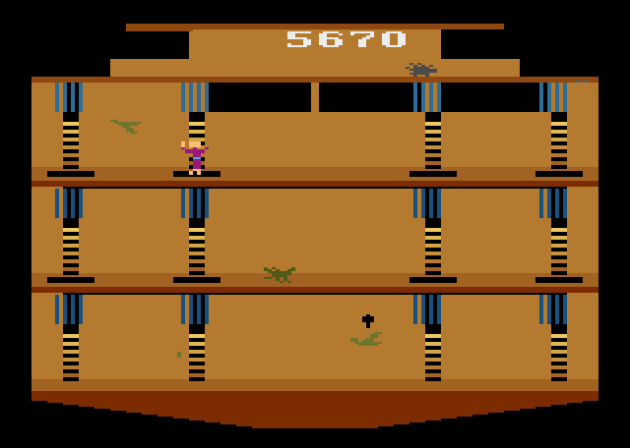
I’m not sure why Noah is dressed like Hugh Hefner (thanks Rafael!) but it makes perfect sense since the toughest part about this game is getting off….. the ladders. The baby alligator is an interesting idea for a game like this, as it will move towards when you start to climb up or down to its platform, then stop moving. It provides a greater challenge than simply going from point A to point B. SMART. See, even the worst prototypes can have good ideas.
You expect religious-themed games to be bad, and yea, Arkyology is horrible. But, it didn’t have to be. Where it goes wrong is in the ladder mechanics, which make you long for the staircases in Castlevania. Getting on the ladder is easy. It’s the getting off them part that isn’t. Even lining up with the platforms isn’t the problem. According to the Arkyology page on AtariProtos, you have to use diagonal movement to get off the ladders, but even that was a coin flip on whether it would work. Well, more like a dice roll, as a coin flip is 50/50, and I spent most of the game stuck on the ladders while wiggling the controller trying to let go. Because the target is constantly changing, this is a deal breaker by itself, but it’s hardly the only problem. While the baby alligators are a good idea, speeding up the action to the degree Arkyology does is a really bad idea. By day four, I found the game unplayable. Collision is a problem, as hitting the latches that open the doors, or feed the animals, was inconsistent. You seemingly have to jump at angles, but often I clipped right through the target and had to complete several passes before it registered. Fix this, and especially fix the ladders, and I think Arkyology might have risen to the level of the best “Christian” game ever. I’m not even joking. It’s not a bad idea for an action-arcade game at all. Unfortunately, with the broken movement mechanics and collision detection, all this brought forth was two of every swear word.
Verdict: NO!
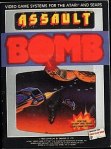 Assault
Assault
Platform: Atari 2600
Year: 1983
Developed by Onbase Co. Ltd.
Published by Bomb
No Relation to Assault (Namco – 1988)
Who the heck is Bomb? Apparently they were the North American partner of Onbase Co. Ltd. Who the heck is Onbase Co. Ltd.? Apparently they were a Hong Kong-based game developer who did a few Atari games. One of them is named “The Great Escape” but it has no connection to the famous Steve McQueen movie. I would have done that one, but it was too generic. Assault had decent graphics, and even if the gameplay is generic, it’s generic within the acceptable parameters. There’s a mother ship that drops enemies onto the playfield, maxing out at three big ones at any time. After a few stages, the big enemies split into two smaller ones. After killing ten of one enemy type, you move to the next wave and next enemy. There were several moments playing Assault where I spontaneously died and I have no clue why. I rewound the game looking for projectiles or some kind of indication. Eventually, I figured out that the meter in the bottom right corner tells you whether your cannon is overheating or not.
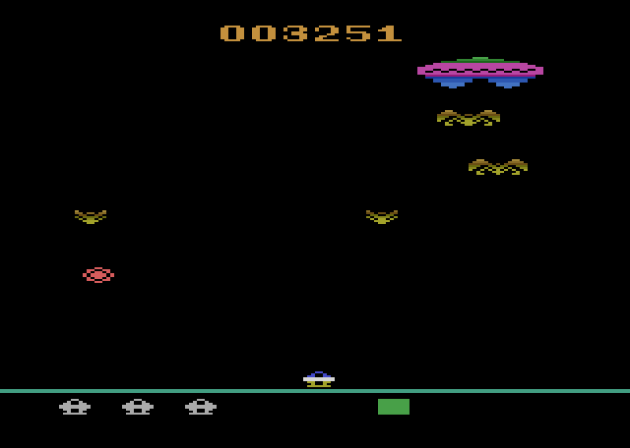
As far as I could tell, there’s no way to destroy the mothership. Oddly, the instruction book implies that it’s possible. Really, the game needed more things like the fireballs enemies drop, or it needed to give the mother ship more of a reason to exist. It’s not bad, but it had no chance of holding up at forty years.
It’s not the worst idea for a gallery shooter, as the heat meter successfully discourages spamming the fire button and incentivizes accuracy. Interestingly, firing upwards into the playfield is done just by pressing up. One enemy type can drop fireballs onto the floor that will heat seek the player, and that’s when you press the action button while moving in their direction to shoot them down. Eventually, Assault resorts to that tried and true Atari cliché of off-and-on invisible enemies. Honestly, Assault isn’t that bad a game for budget label release by a nobody developer. Original? Nah. Almost decent? Yea, actually. I wouldn’t want to be stuck with it today, but it’s not a bad little game. Moderately decent scoring system. Moderately decent learning curve. It feels like an actual effort went into it. A reminder that not every samey space shooter on the Atari is drowning in cynicism. I can’t give it a YES! because I wouldn’t actually want to play it today, in 2024. But, I found it comforting that kids in 1983 could buy really cheap games by a no-name developer and not get stuck with unplayable garbage. At a time when Space Invaders was cutting edge, I imagine a game like Assault would have been a lot more exciting. My review system might not take that into account, but my heart does.
Verdict: NO!
 Atlantis
Atlantis
Platform: Atari 2600
Year: 1982
Designed by Dennis Koble
Published by Imagic
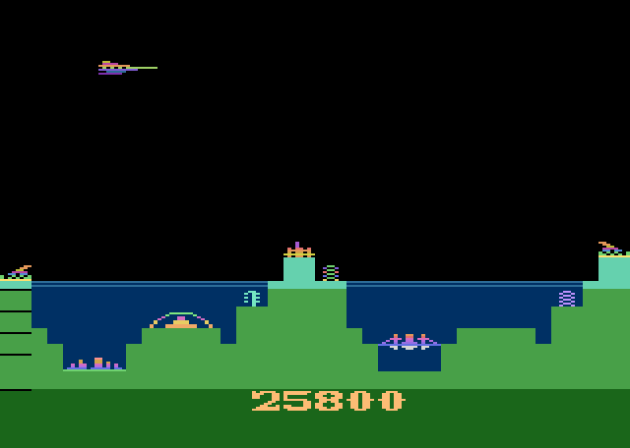
I love how the instruction book gives an overly-elaborate explanation for all the stuff on the screen. Atari developers really went all-out on their games.
Atlantis as a game isn’t that interesting. It’s like a less complicated version of Missile Command. You control three cannons and have to shoot down enemy ships. The ships fly in a straight line over the playfield, and every time one avoids your gunfire, it makes another, closer pass. Eventually they’ll get close enough to unleash an attack on one of seven structures on the surface. Lose all those and it’s game over. Shooting the center cannon is easy-peasy. Just press the fire button. But, my damaged brain refused to work with the other two cannons, which shoot diagonally. For some reason, my gray matter only made it as far as “if you want a bullet to intercept a ship on the left side of the screen, shoot the left side of the screen!” when really I wanted to shoot the right cannon. It took me a while to get the hang of it. It’s not a bad game by any stretch, and I especially liked how satisfying it was to hit the little ships out of the sky. Not only do they score more points, but they knock out the other ships on the screen. Like many Atari 2600 games, this would have certainty been a much more exciting game when it first released, but the test of time hasn’t been kind to it. Popular in its day, in 2024 Atlantis gets old quickly. Normally I’d render my verdict here, but there’s a funny story about Atlantis. Back in the day, it was part of a competition, and players who scored over 900,000 points were given a “sequel” cart, Atlantis II, for the championship round.
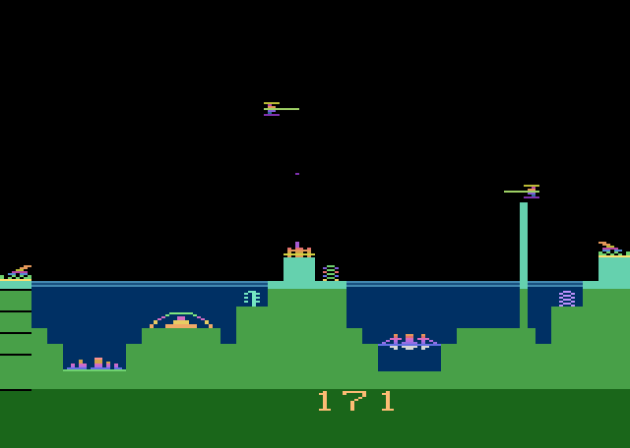
This screen is of Atlantis II.
Atlantis II is really more like a fifth mode for the game with the difficulty set to the extreme. The ships are much faster and the scoring is much, much lower. But, it’s the same game that I couldn’t wait to be finished with. The carts were shipped to homes, and whoever put up the highest score on this cart would win $10,000.. IN GOLD! I’d like to think there were grizzled prospectors out there that devoted their lives towards getting good at Atlantis, all while saying “gimme that gold!” But here’s the really funny part. Apparently, the Atlantis II carts were just Atlantis I carts with a new game in them. They shipped in normal Atlantis I boxes, only these had a plain white sticker stuck on them that bluntly says “ATLANTIS II” on top of the normal Atlantis I art. Guess what the carts themselves DO NOT have on them? No identification they’re Atlantis II at all. So, if you’re reading this and you have a copy of Atlantis on the Atari, your copy could actually be Atlantis II, a highly desired collectible. That story was so much more interesting than the games themselves. Even with bad Atari games, I’m often caught off guard by how much time has passed since I’ve started playing them. With Atlantis, I kept looking at the clock and wondering how so little time had passed. Eventually I decided thirty minutes was quality time enough.
Verdict: NO!
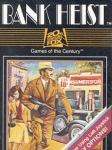 Bank Heist
Bank Heist
Platform: Atari 2600
Year: 1983
Designed by Bill Aspromonte
Published by 20th Century Fox
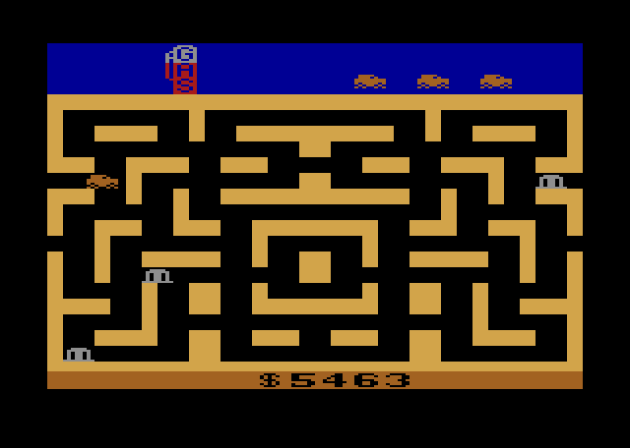
It ain’t much to look at, but this wasn’t that bad. Kind of weird 20th Century Fox couldn’t find a heist movie to tie this to.
On a platform with a plethora of maze chase games, Bank Heist actually does manage to somewhat stand out by changing up the formula. The collecting concept is simple: banks randomly spawn on the map (or appear in preset locations if you toggle the RIGHT DIFFICULTY SWITCH to B). Grab them and score points. The simplicity ends there, and actually, Bank Heist is pretty convoluted with its rules. When you collect a bank, after its score vanishes from the screen, a cop car spawns that begins to either chase you (LEFT DIFFICULTY A) or follow a preset pattern (LEFT DIFFICULTY B). As you move, your fuel slowly depletes, and it also goes down a notch every time you use dynamite. Every time you rob a bank, the meter showing how much fuel you’ll have in the next town goes up a notch. If you drop dynamite in a way that blows up a cop car, another bank will spawn in the town, maxing out at $90 per bank per town. The maze has tunnels just like in Pac-Man that pop you out the other side, BUT, the longer right tunnel advances you to the next town over. If the fuel meter is higher than the tank, you get more gas, up to a full tank if the meter is all the way at the top. If it’s under your current gas line, you get no extra fuel in the new town.
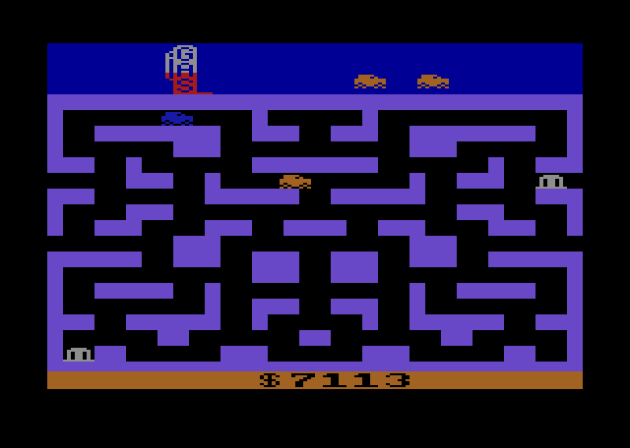
The soundtrack is a terrible car engine noise if there’s no cops, and sirens if there are. It’s awful racket.
Don’t bother with having the cop cars not chase you. There’s no tension at all unless you play on the A difficulty. The cops can’t do u-turns in either mode, and so following them is actually a viable strategy if you need to do tight squeezes. However, you do actually have to kill them in order to build up your fuel, and to do that, you have to let them be right on your tail. The dynamite has a short fuse, and getting the timing of it down is really tricky. This is probably one of the better maze chases on the Atari 2600, and I still didn’t love it. It probably was a good idea to try and make a more complicated maze chase. I’m sure Atari owners were ready for that by this point. But, the final product still needs to be fun, and Bank Heist is just sort of dull. The mazes lack elegance and the type of logic that creates tons of close calls that makes the Pac-Man formula work. It’s the classic mistake that so many of these types of games make: the chase is the fun part. Collecting stuff is just a means to achieve that. So, Bank Heist is a NO!, but it’s near the top of the NO! pile because it plays fine. It’s just not fun in 2024. Close, but not quite.
Verdict: NO!
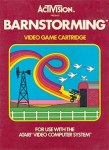 Barnstorming
Barnstorming
Platform: Atari 2600
Year: 1982
Designed by Steve Cartwright
Published by Activision
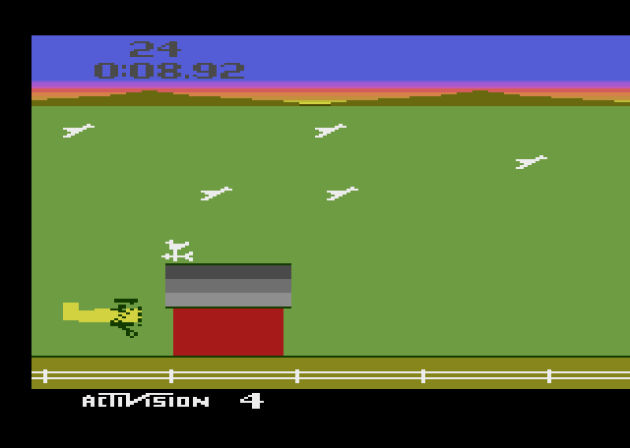
Besides towers, this is the whole game. And it’s kind of awesome.
Oh for the days when you could release a full-priced game where the average round lasts under a minute. An even more remarkable achievement is that Barnstorming doesn’t even feel like a rip-off. Of course it helps that the game in question is roughly as addictive as crack. Barnstorming’s concept is simple: dodge birds, avoid windmills, and fly a plane through barns. If you just hate life, you can even shrink the clearance in the barn, but we went for the easiest mode. It was tricky enough. If you hit the windmills or the roofs of barns, you recoil. The birds, on the other hand, are pushed forward instead of becoming what I believe professionals refer to as an “engine problem.” It’s actually really smart design. The birds fly in three channels in the sky, and because hitting them slows you down slightly while sliding them forward, the one you hit inevitably remains an obstacle that you still have to dodge. Sometimes, you can really screw a run you’re on by hitting a bird in a way where it lines up with the other two channels, creating a solid barrier. That’s fine if you’re about to dip out of the sky to fly through a barn, but if you’re over a section with several windmills in a row, your final time will hurt for it.
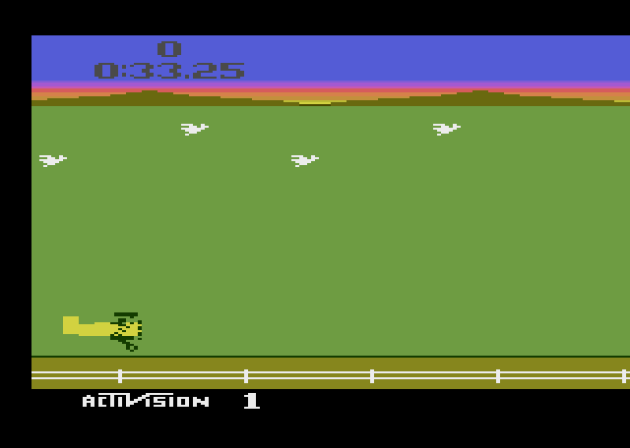
The world record for mode one in Barnstorming is 32.64. So honestly this ain’t bad. I’m not entirely sure what I could have done to do better. My dad and I were usually finishing in the 34 second range, but we did post time of 33.75 (Dad), 33.55 (Dad), 33.54 (Me), 33.52 (Me), 33.99 (Dad), and the above score of 33.25 (Me). We both agreed to stick to pinball for record chasing.
Modes 1 – 3 are preset courses, and while the game is always limited to birds, windmills, and barns, it’s really no different than practicing up at a racing game like Mario Kart. Same concept, different form of racing. You can also play mode four, which completely randomizes the order of barns and windmills. This is one of the cases where having a randomized course doesn’t interest me as much, because I’d much rather play a fixed course and challenge my personal best times. Honestly, for such a small, confined idea, this is a dang good game. It’s ahead of its time too, because it feels tailor made for handheld gaming. I could seriously see Barnstorming becoming one of my go-to “five minutes to kill while waiting in a doctor’s office” games. It’s especially suitable for that, as it requires one of the lowest time commitments of any really good game I’ve played. One other thing stood out to me while playing this: it would make a pretty good LCD game, don’t you think? Well, it turns out that in the 2000s Burger King did put out an LCD of Barnstorming (along with Tennis, Kaboom, and Grand Prix). Some tell this to Itizso.
Verdict: YES!
 Beamrider
Beamrider
Platform: Atari 2600
Year: 1984
Designed by David Rolfe
Published by Activision
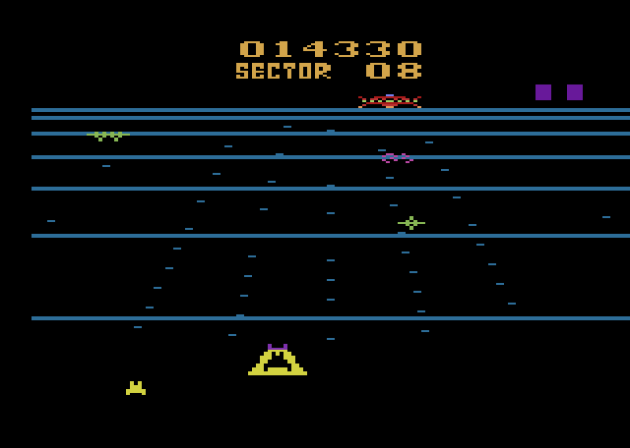
The dots on the screen remain completely stationary, but the moving lines combine with them to successfully create the illusion of forward momentum. Clever.
What is with Activision and games that would work well in LCD format? In Beamrider, you move along five channels shooting enemies. The catch is there’s really only one enemy that matters: the white flying saucers that eventually become bashful about putting themselves in the line of fire. Every stage has fifteen of them. Almost everything else that falls on the playfield is indestructible without using one of your limited bombs. You’re incentivized to save those bombs until after you shoot down all fifteen saucers, because then a mothership slowly crosses the top of the screen that can only be blown up by the bombs. You only get one pass before going to the next stage. The mothership is more like an end of stage bonus round where you can still lose a life. Shooting down the mothership with one of your bombs earns you bonus points for every reserve life you have, which can be quite a lot. Also, mines come in and block your shots on it, and like pretty much everything but the saucers, your normal bullets don’t destroy the mines.
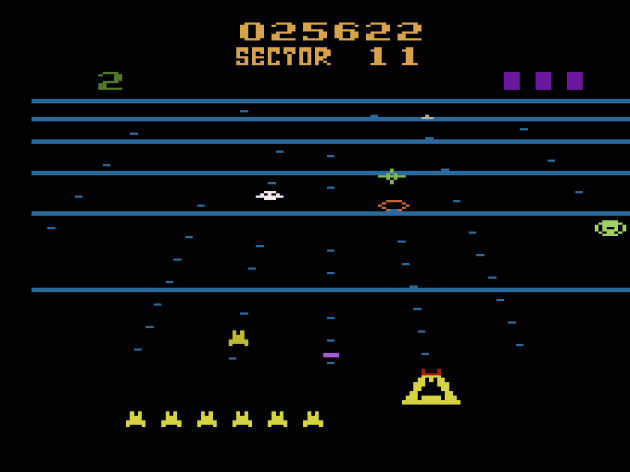
There’s a nice variety of obstacles too. There’s a lot game packed into this one.
Another twist is Beamrider is one of the most generous games with extra lives I’ve ever seen. The only catch is.. well, you have to catch them. Sometimes enemies make it impossible, and sometimes YOU make it impossible. If you shoot the extra life that drops, it turns into debris that you have to avoid. You’ll want to stock-up on lives, because as things progress, you encounter a lot more enemy fire, obstacles that shield the saucers from your shots, and even things that, if you miss shooting them, will linger at the bottom of the screen, preventing you from moving (unless you want to die) for a few seconds. Beamrider is actually a lot of fun and one of the best shooters on the Atari 2600. It’s certainly one of the better 2600 games in terms of handling difficulty scaling. It even has convincing 3D graphics, or at least as convincing as this era got. As a post-crash release, it stinks that it doesn’t get more attention as one of the better titles on the VCS.
Verdict: YES!
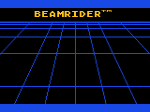 Beamrider
Beamrider
Platform: Atari 5200
Year: 1983
Designed by David Rolfe
Published by Activision
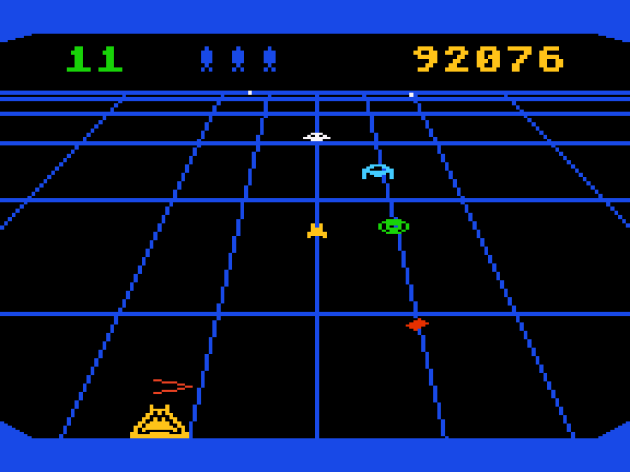
While the graphics are impressive, it can be hard to tell apart enemy bullets from the ultra-dangerous red mines you’re about to read about.
No surprise: Beamrider on the Atari 5200 is really good. It’s more or less the same experience, with two key differences. From level 14 onward, red colored mines start flying in from around the side of the screen. If you don’t shoot them before they reach the bottom of the screen, they can move one channel over. In a game where you only have five channels to move and there’s more than one obstacle that can clog up a channel, that’s a pretty tough enemy to deal with. Shooting them neutralizes the “move a channel over” part, but they’re still on the playfield, and since they enter the playfield at the midway point, you’re always cutting it close. Combine that with another mine type missing from the 2600 version that forces you to move in the opposite direction it’s moving in, and this should be a MUCH harder game, right?
Well, no. Remember the whole “generous with extra lives?” bit from the 2600 game? The 5200 is even more generous. It wasn’t rare for the game to spit out two lives in a single level, and I think once it even did three. Unless I didn’t notice that I changed level because I completely zoned out while I was playing it. That’s possible. As expected, the Atari 5200 version plays a little slower than the 2600 version. This is especially true of the mothership moments. It’s really hard to shoot them down in the 2600 version, especially after ten levels. The timing is completely different in the Atari 5200 version, not just for how fast the missiles you fire at the mothership travel, but how long it takes for the mines to clear, giving you a clean shot at it. Slower speeds is a trademark of the 5200, but Beamrider is one of the few games better for it. Finally, I should note that I had my best rounds when I used a keyboard instead of a game controller. By far my most common death was overshooting my movement, something I didn’t do on a keyboard. Would THIS have been better with the floppo 5200 stick? So far, Beamrider is one of the best 5200 games I’ve played. Maybe the best. It’s in the discussion. I could see how someone might think it takes too long to build up if you play on the normal difficulty, but I’m fine with it. This scales perfectly, and the absurd amount of extra lives eventually feel just right.
Verdict: YES!
 Beat ‘Em & Eat ‘Em (and various other X-rated VCS games)
Beat ‘Em & Eat ‘Em (and various other X-rated VCS games)
Platform: Atari 2600
Year: 1982
Designed by Joel H. Martin
Published by Mystique
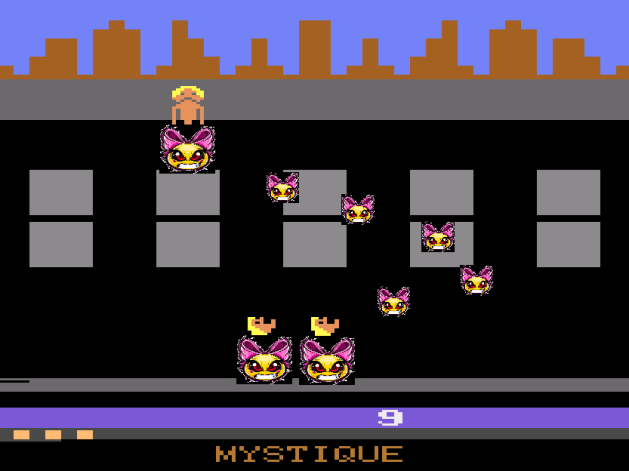
This isn’t adult entertainment. It’s satire. It’s a parody. Just, not a very good or funny parody. Also, sorry for the censorship, not that anything looks like it should. The actual game is a very poor version of Kaboom! Nobody ever bought these seeking quality games. A round of Beam ‘Em & Eat ‘Em lasts about ten seconds, and that’s how long it’s funny.
Alright, let’s get this over with. Have you ever heard of Rule 34? I found the exception to that, and it’s ironically the games that are seemingly designed with the intention of being erotic for the Atari 2600. Nobody has ever gotten off on these games. Ever. There’s a handful of these “adult” games that are neither sexy or arousing, and they’re not really fun either, meaning they fail at both as pornography and as a video game. But, there is kind of something they do succeed at, and I don’t even mean ironically. They succeed as novelties. I could totally imagine something like this being sold at a Spencer’s. Is it THAT far-fetched? The whole point of their adult novelty section is for people to buy joke or gag products you show off to friends, soak in the reaction, and then shelf until you’re visited by the next person who you feel comfortable showing that you have a somewhat depraved mind. That’s what these are. Jokes. More expensive jokes than, say, a pack of genitalia-shaped breath mints called “Peckermints” (yes, this is a real thing) but jokes nonetheless. So, actually, I get what they were REALLY aiming for with these, and had they gotten distribution in a place like Spencer’s instead of going the adult store route, they might have been successful. Oh, as games? No. They suck. But, I get it.
Verdict: NO!

You must be logged in to post a comment.